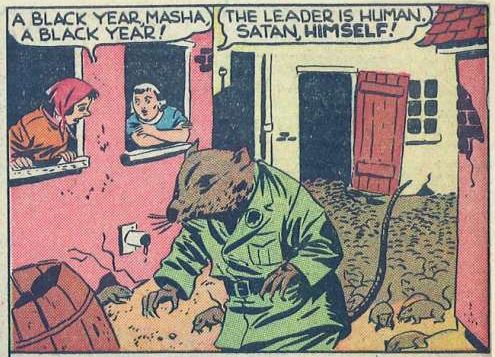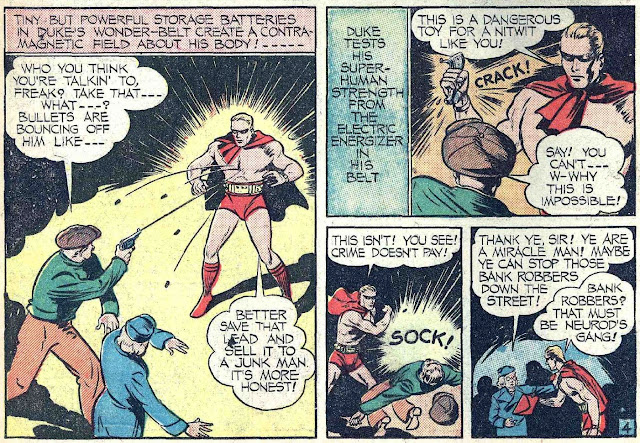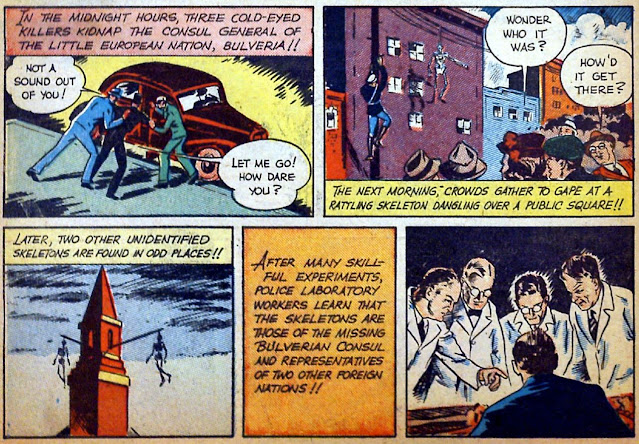More of these guys and their antics.
Johnny Fox:
Johnny Fox is a guy* from the Florida Everglades who visits his grandfather one day to find him the victim of a treacherous murder. And what's worse, the murderer, one Peter Pokane, did so in order to steal a supply of "sun-shots", i.e., invisibility pills.
*and by "guy" I mean "Native American guy of the Seminole Tribe of Florida" but it's a tricky thing to work into a concise sentence. Also tricky: the racial politics of the Johnny Fox comic! Johnny is a college-educated Seminole and thus free of a lot of the overt stereotypical behaviour of the day but also is a near-superhuman even without the invisibility pills, explicitly due to his Noble Savagery. Plus Peter Pokane's major villainous trait is that he's a "half-breed" which... must I explain why that sucks? What I'm saying is that it's complicated.

Johnny gets the sun-shots back by yeeting Peter Pokane out a penthouse window and begins fighting crime, invisible-style. Keeping in mind, of course, that he has to take a pill to turn invisible and another to turn back. Unless he gets hurt, which will turn him back immediately. Which happens a lot, because Johnny may be invisible, but his shadow never is. As far as invisibility goes, this version might have the most caveats I have ever seen. At least he doesn't have to be nude.
After a while the writers seem to get tired of the invisibility gimmick and have Pokane return just long enough to take the sun-shots to a watery grave (and it's a rare villain who gets killed by the same hero twice). Johnny Fox is now just a regular bow-wielding New York City Private Detective... for about two issues and Johnny's grampa's ghost returns to teach him how to make them. (Champion Comics 006, 1940)
the Human Meteor:
Duke O'Dowd was just a regular Texan serving as a French Foreign Legionnaire until a couple of issues in, when his writers presumably realized that comics about the French Foreign Legion are boring, repetitive and usually pretty racist (though they probably cared more about the first two reasons). So they made Duke homesick, had him earn an honourable discharge and sent him on his way in a plane piloted by fellow Texan Kerry Flynn - an unlucky break for Flynn as it turned out, because somewhere over the Himalayas the two were caught up in a mysterious tornado and blown to the hidden city of Bayakura, a journey that only Duke O'Dowd survived.
Hailed as the Great Deliverer, O'Dowd is introduced to Bayakuran scientist Dr Wah Lee, who outfits him with the Wonder Belt, a superscientific device which provides him with super-strength, the power of flight and invulnerability to metal. Plus he gets a stun ray gun! And a very fun and goofy outfit!
Duke puts down a rebellion by the very low-achieving heir to the throne of Bayakura (his aim was to take the riches of Bayakura to the outside world and live like a king but he decided to do so via a huge heist rather than the traditional and much safer option of embezzling from the kingdom while in power) and installs Wah Le in his place befpre heading to the outside world himself.
Sadly, once O'Dowd rejoins the outside world he trades in the amazing Bayakuran national costume for a more traditional super-hero getup (though the Bayakurans seem to have varied up their outfits as well - perhaps their fashion industry was revitalized by O'Dowd's fresh new looks). He also switches names, from the Great Deliverer to the Human Meteor, which is admittedly more snappy.
The Human Meteor is also the first character we have encountered who will someday be done dirty by Roy Thomas in 1993's Invaders v2. Briefly, Thomas had the idea to field a team of super-heroes who had defected to the Nazis against the Invaders and since he wasn't allowed to use any actual Golden Age Marvel characters he instead opted for the public domain.
While my initial instinct is to reject this idea... I must admit that it's not without merit. Plenty of otherwise rational people were also charmed by the fascists - it's unreasonable to think that no superfolk would ever compromise one aspect of their morality for another (it is a badly-written comic, because it's a very 1990s comics). So what we're going to do is not assume that we'll get to it later (three years into this project and I still haven't gotten to 1942, after all) and instead we're going to evaluate just how much of a stretch it was for each character to end up as a Nazi.

While Duke O'Dowd is an adventurer and thrill-seeker who joined the French Foreign Legion for a larf and never really expresses complex morality as opposed to simple justice-seeking, his stated reason for joining the Battle-Axis is that his Boston Irish blood demanded it, which... is plausible as a motivation for attending a few meetings but a huge stretch when it comes to attempting to kill Captain America. (Champion Comics 008, 1940)
Robinhood Jones:
"Rich guy who gives it all up to become a do-gooder hobo" wasn't the most popular trend in early comics but I can conjure up at least half a dozen examples. Robinhood Jones has the added distinction of being a pretty direct pastiche of - you guessed it - Robin Hood and his Merry Men. Some highlights:
Robin Hood - Robert Harrison Jones III
Friar Tuck - Fry Tucker
Little John - Little Jack Lee
Will Scarlet - Bill Scarlet
Alan-a-Dale - some guy named Allen
There's also a fairly delightful swap of archery for horseshoes as an all-purpose solution. Funnily enough, though Robinhood Jones squared off against the same crooked Sheriff of Sherwood City on thereabouts on two separate occasions he never encountered a clear Prince John analog. Or a Maid Marion, for that matter. (Champion Comics 007, 1940)
the Black Ghost:
AKA the Black Rider, the Black Ghost was an alternate identity adopted by cowboy hero Bronc Peeler (himself the character prototype for the slightly less outlandishly-named Red Ryder) on one of the many occasions in which he was framed as a crook and had to prove his innocence. Of note mostly for his very cool outfit consisting of jet black cowboy gear with a white bandit mask. (Popular Comics 039, 1939*)
*Originally a comic strip that was reprinted in Popular Comics, if you're truly interested.




























































